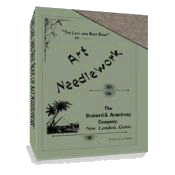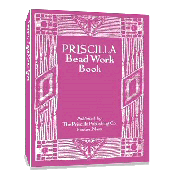1895 Christmas Buying Hints
These 1895 Christmas Buying Hints are not only a great insight to what items Victorians considered appropriate as gifts but also shows that although hand-made gifts were appreciated, those with money had many beautiful items to choose from to buy.
Hints for Christmas Buyers
— by Clare Bunce
Harper's Bazaar, Dec. 1895
It has been said, and doubtless wisely, that the ideal gift embodies no use; that it should be a thing of rare beauty, of infinite grace, but serve no plebeian end of service. Use and beauty, however, are so deftly combined in these days, and, this year in particular, are so blended into one, that the rule becomes a difficult one to follow. To be sure, the line can be drawn and purely decorative objects can be found, but hose of service are so attractive, and appeal so completely to one’s sense of fitness, that there is constant temptation to overstep the mark.
In the case of a gentleman sending greeting to his ladylove, or even to a valued friend, the rigid rule might well be borne in mind, but between women folk or members of the family group it would seem quite possible to modify its stricture and still keep well within the lines of good taste.
The two real novelties of a purely ornamental sort are the blue Rookwood pottery and the Doulton-Holbein, and were there a thousand from which to choose scarcely one could be found more delicate in color than the one, more vigorously splendid than the other.
For years we have been proud, and justly so, of our purely national faience, but until now its colors have all been of the deep rich reds, browns, and greens. Quite recently the lovely blue was put upon the market, and it seems to have come just in time for the popular craze. Delft is the pottery par excellence in the fashionable world, and all sorts of fine blue wares seem to shine by its light, as it were. In themselves and of themselves they are lovely in the extreme, but the fact of being the vogue gives them additional value as gifts. The blue Rookwood retains all the essential characteristics of the warmer tones and shows the same perfection of treatment.
The Doulton-Holbein, while essentially different, is equally delightful and welcome as a new thing is sure to be at Christmas-tide. It is substantial, as is all the Doulton ware, but, as its name suggests, owes its inspiration to the great painter’s work. It is splendid, rich in color and in treatment, in every way a complete contrast to the dainty blue ware. Yet the two are the leading novelties of the season in fine pottery, and are quite similar in price. Eight dollars will purchase a good specimen of either, while at the same time many times that amount can be expended.
Cut glass is now more splendid than in has been in years past, and is shown in greater variety both of pattern and shape. One of the very latest objects is the flask for masculine use. It is to be seen with a silver stopper, and is altogether a most elegant trifle, which need not cost more than six dollars, while at the same time it can be made to touch almost any figure on may elect.
Cigar-jars are novel also, and in the brilliant glass are so handsome as to be attractive quite apart from their use. Nevertheless, the fact that one will keep fifty cigars in perfect condition is sure to commend itself to the masculine mind, and every woman knows how much more difficult is the selection of gifts for men than for women folk. The jar sells for ten dollars and even less in some simple designs, and, as was stated in the beginning, is a thing of real beauty so clear and brilliant is the glass.
Rock crystal is almost entirely new to this market. A few pieces have been imported and sold at high prices, but this year for the first time it is made at home, and is offered at comparatively low prices. The glass is somewhat heavy but perfectly clear, and the decoration seems to combine etching with cutting in a way to produce a most fascinating effect. A jug of moderate size costs nine dollars, so that even now it is far removed form cheapness, and belongs among the more select varieties of tableware.
The miniature seems to be of all forms of decoration the one preferred for objects upon which it is a possible thing. The very last development is the miniature purse, but there are a whole host so decorated from which to choose.
Miniature buckles or belt clasps, too, are new and make lovely gifts for young girls. In price they range from nine to fifteen dollars, and may safely be said to be delightful at every stage. One of the higher-priced sort sows a setting of carved gold plated upon silver, and is seen on a belt of soft creamy white. Various colors in the belting are to be found as a matter of course, but no one acts as more perfect fit for the clasp than pure white.
Change-purses, themselves made of pure gold or silver, with heads set in the clasps, and most exquisite vinaigrettes with similar devices as stoppers, are also seen, and go to make up the almost endless number of objects on which this most popular form of decoration is to be found.
Russian enamel, or enamel copied after the Russian — for of late we make our own — is another extremely elegant and most popular adornment for numbers of beautiful things shown in honor of Santa Claus. One of the newest is a bag of the chatelane order made of heavy silk or velvet, and showing a clasp of the gorgeous enamel. It is designed to hang from my lady’s belt, and to keep safe her purse, her dainty handkerchief, and the like; but it has become an object of so great value as to require guarding for its own sake. From twenty-five dollars to seventy-five is the price given, and even at the lowest the bag is a really splendid affair.
Photograph-frames, belt-clasps, spoons and ladles of varying use, all are seen in the wonderful blues and translucent reds that seem more like jewels than enamel; but the latest development on an extravagant scale is the making of stands in place of saucers for the tiny coffee-cups of after-dinner use.
These are certainly exquisite. They show perfect coloring and graceful shape. The cup rests within and is handleless, the sand being supplied with the handle, and all being raised to the lips. A complete service showing the cups, stands, spoons, and server runs way up into the hundreds in price, but is to be valued as an art product, even though its possession be left to the few.
Fine etching has been given a decided impetus, and with its help some strikingly artistic bits of furniture are offered as gifts that cannot go amiss. Koran stands, or stands made after their style, make most delightful photograph-holders or engraving-stands, and can be purchased for six dollars.
The burnt etching seems singularly harmonious with the general style of the stand, and the whole has an antique effect difficult to produce by any other means. A mirror, oblong in shape and of generous size, sells for nine dollars, and a dressing-table that seems to speak of ages past and gone, so wonderfully rich are its tints, for thirty, while smaller articles can be had for correspondingly smaller sums.
In all the wonderfully quaint effects remains, and as they are shown this season for the first time, they can safely be said to be novelties, and so to fill the one overwhelming need. “A thing of beauty is a joy forever” is the axiom that once was taught; but while these special objects combine novelty with beauty, the demand of the age seems to be for the new whether it be beautiful or not.
Simpler and less costly gifts showing etched ornamentation are to be found by the score, and, although possibly not so entirely new, as the furniture and mirrors, fill a more general need; for in this world the purses of limited power far exceed in number those of Fortunatus’ make. Among these latter some few real novelties are show, however, and it is quite possible to find tasteful remembrances made from both sole-leather and ooze or undress calf-skin.
A pretty trifle that is sure of a place on nay lady’s desk is an appointment card, which provides for all the days of the week. It costs only two dollars, yet is artistic as well as useful, so that even the strict rule of making a gift for its beauty alone might allow of including it and sundry other devices of a similar sort.
But a decoration known as Delft, and that is an out-growth of the mania for the pretty, is still more novel, although it scarcely can be said to resemble the famous Dutch vases and plaques, for it is sketched on blue linen in white paint.
Silver is always productive of good things. This year the list is only a little longer than heretofore. For all good men who smoke, and their name is legion, there are new things and good things by the score.
A whole Colonial outfit, including tray, spirit-lamp, ash-receiver, match-box, and cigar-holder, can be bought or ninety-five dollars, a tobacco-jar with a top which forms an ash-receiver for thirty dollars, and one showing an enameled over with a suitable smoker’s design for forty-five, while a dainty cigarette-box, cedar-lined, is scarcely more than half that price.
Lamps and trays are of all sorts and all values, but these few objects are new, and accordingly their price is rather more than that of good but familiar things.
In woman’s realm greater moderation reigns. The latest and most charming berry forks, showing the ripe strawberry and its dainty leaf in each handle, are sold for sixteen dollars a dozen, and the very newest tea-strainer, which is a miniature basket of silver with a handle of ivory, requires only an outlay of four.
As a matter of fact the market is well supplied. Christmas buyers have need only to fix each upon her own limit and to abide thereby. For fifty cents some attractive trifle can be bought. For fifty dollars a gift of elegance can be select with ease. Between the two is infinite variety. Wisdom and peace do but demand that when one dollar is the limit of outlay objects worth ten times the sum shall be ignored.
Weariness and exhaustion are the only results of the continue attempt to make one stretch itself into five. Good taste and a kind heat will be sure to find something suitable, let the limit be what it may. If the struggle to emulate a richer neighbor, or to make a more pretentious showing could but be eliminated from the season of peace and good-will, how much happier we all should be, how much more truly merry our Christmas day!
Return to top of 1895 Christmas Buying Hints page
Return to Victorian Christmas page
The Last and Best Book of Art Needlework
Over 100 pages of authentic Victorian instructions and patterns from 1895!
FREE
Beeton's Book Of Needlework

433 pages!
Sign up for VEAC! Everything you wanted to know about Victorian embroidery, needlework, crafts and more!
Priscilla Bead Work Book
Make Beautiful Victorian Beaded Purses, Jewelry & Accessories - Starting
TODAY!



